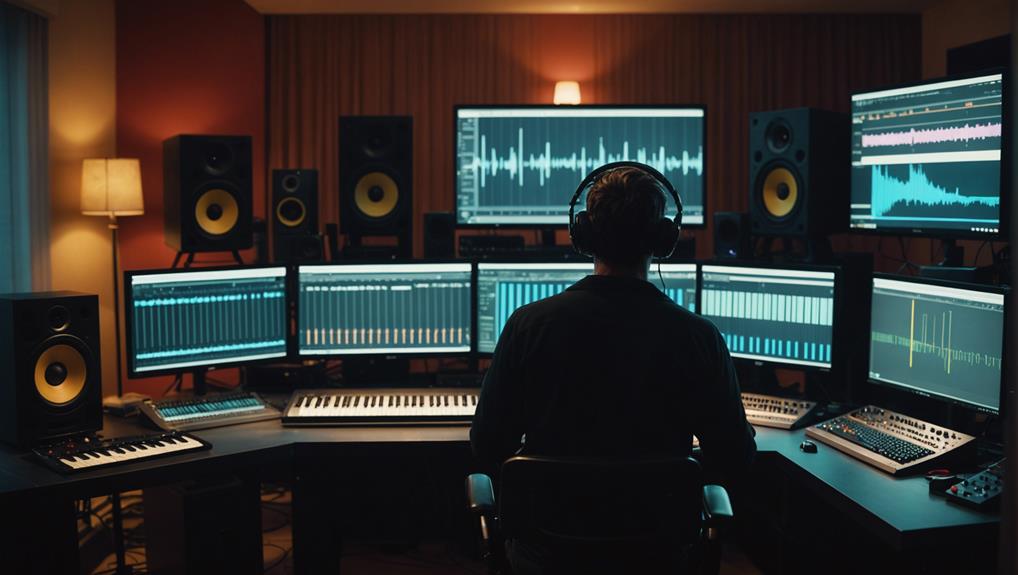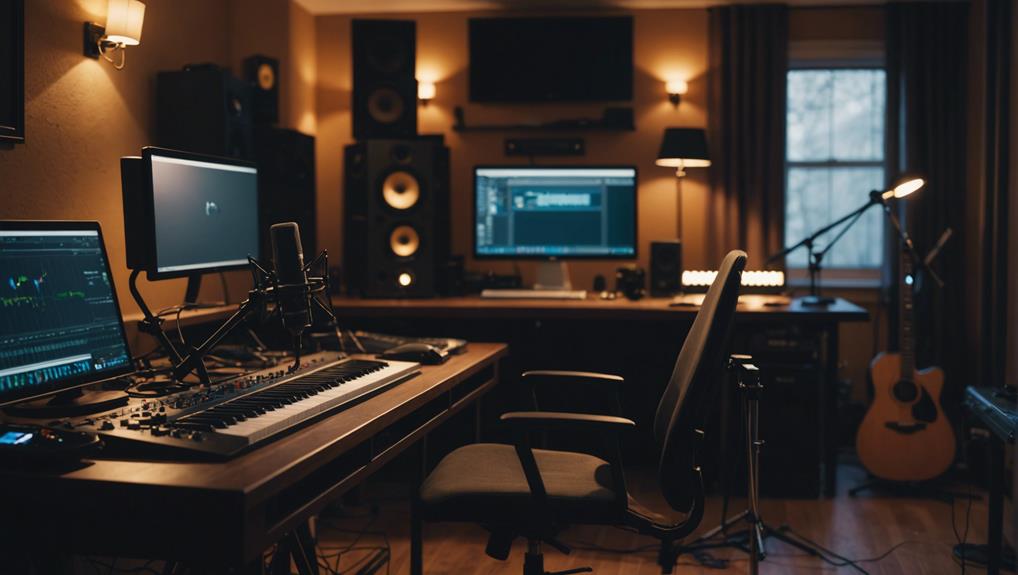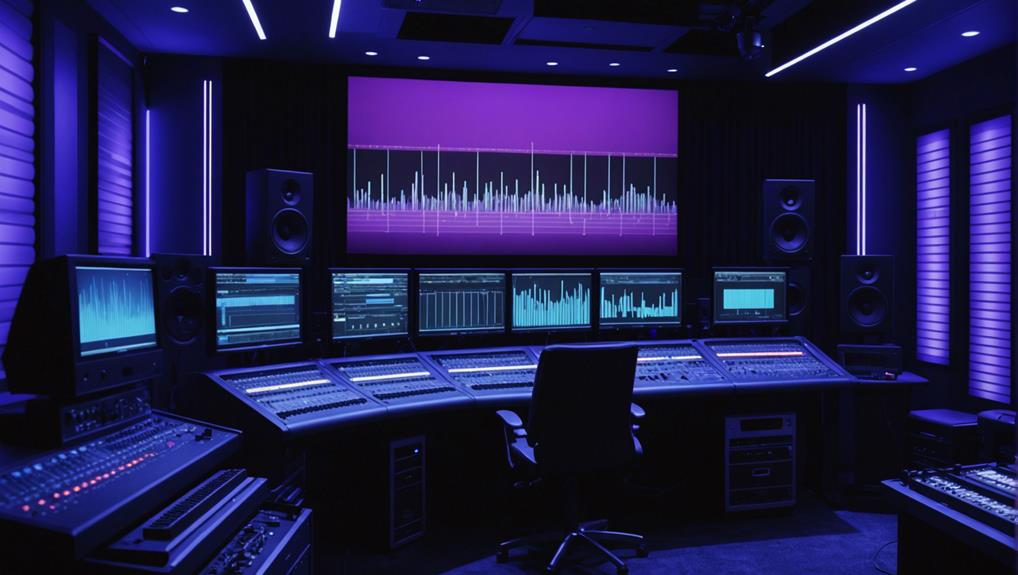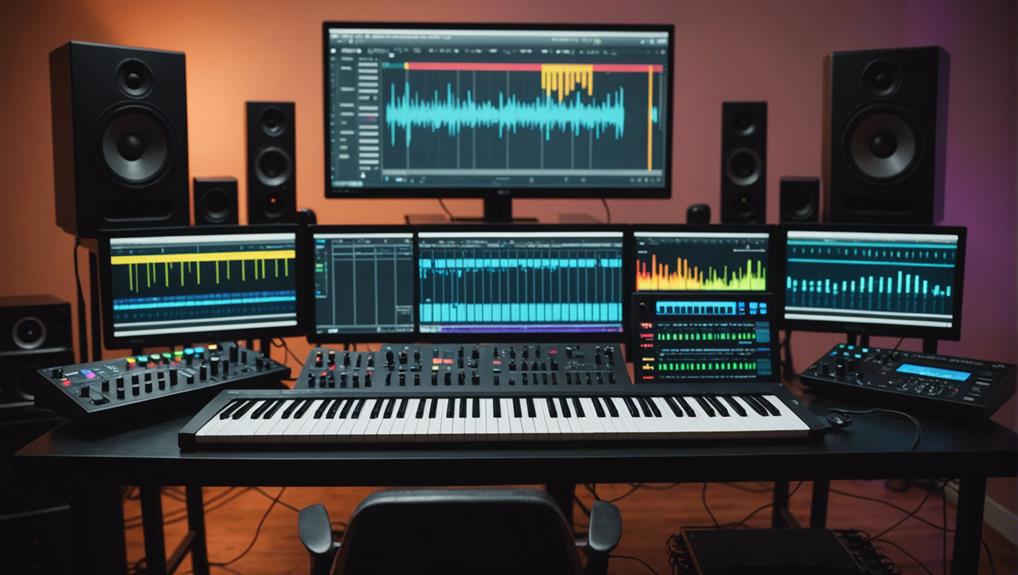When it comes to sampling in music production, you’re not just grabbing random audio snippets; you’re curating sounds that will breathe life into your tracks. Start by exploring various sources, like online libraries, vinyl records, or even field recordings, each offering unique textures and tones. Understanding where to find these samples is just the beginning. You’ll need to navigate the legal aspects and learn how to manipulate these sounds in your DAW. So, how do you transform these samples into something truly innovative? Let’s explore further.
TL-DR
- Extract Audio Segments: Capture drum loops, vocal snippets, or instrument riffs from existing recordings for new music creation.
- Manipulate Samples: Utilize techniques like time-stretching, pitch-shifting, and chopping to creatively alter and fit samples into your track.
- Legal Clearance: Obtain necessary permissions or licenses for copyrighted samples to avoid legal issues.
- Use DAW Tools: Drag and drop samples into your Digital Audio Workstation and use slicing, layering, and MIDI mapping for arrangement.
- Enhance with Effects: Apply EQ, reverb, and compression to integrate samples seamlessly into your mix.
What Is Sampling?
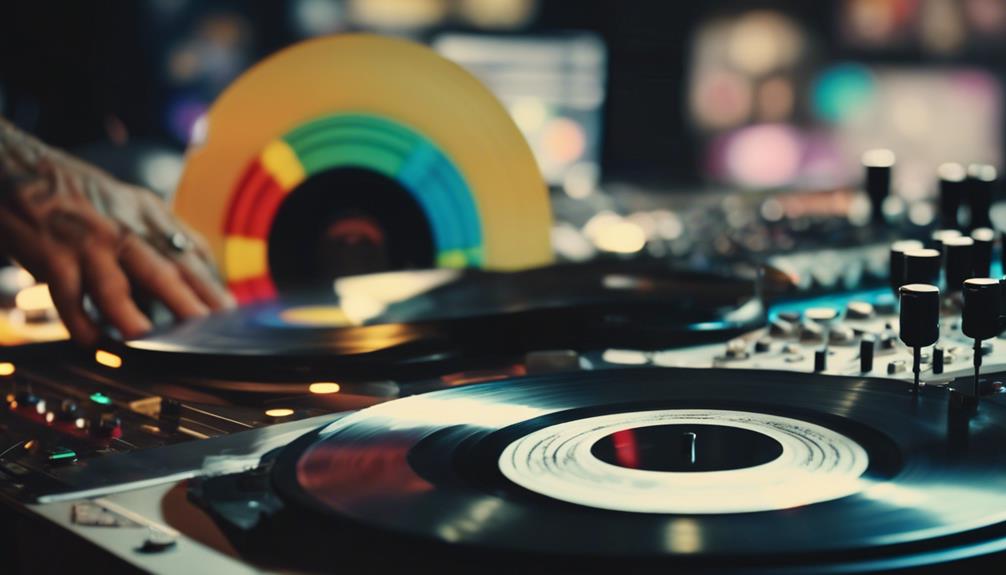
Sampling in music production involves taking segments of audio from existing recordings and reusing them creatively in new compositions.
When you sample music, you can extract anything from drum loops, vocal snippets, instrument riffs, to sound effects. These samples become the building blocks of your new track, allowing you to manipulate, chop, loop, and rearrange them to create unique sounds and textures.
Sampling isn’t just about lifting a piece of audio and dropping it into your project. It’s about breathing new life into those sounds.
You can employ techniques like time stretching to change the tempo without altering the pitch, or pitch shifting to modify the pitch without affecting the tempo. Layering different samples can create rich, complex textures, while applying effects like reverb, delay, or distortion can transform the original audio into something entirely different.
Sampling has its roots in genres like hip-hop and electronic music, where producers revolutionized music creation by repurposing existing sounds.
Over time, it’s become a fundamental aspect of modern music production, offering endless possibilities for creativity. Whether you’re a novice or a seasoned producer, sampling can elevate your music to new heights.
Legal Aspects of Sampling
When you’re sampling music, it’s important to understand copyright and fair use laws to avoid legal issues. You’ll need to obtain the necessary licenses and permissions from original copyright holders.
Alternatively, you can use public domain samples or royalty-free libraries to sidestep these concerns.
Copyright and Fair Use
Understanding copyright and fair use laws is essential for music producers to avoid legal pitfalls and guarantee their creative work remains unblemished. Copyright law protects original works, meaning you need permission to sample them to avoid potential legal issues. Without proper clearance, you risk facing lawsuits, hefty fines, and even restrictions on your music’s distribution.
Fair use, however, offers some exceptions, allowing limited use of copyrighted material for purposes like criticism, commentary, or education. Navigating copyright law can be tricky, but it’s vital to understand what constitutes fair use. While it might seem tempting to rely on fair use to bypass permissions, remember that it’s a narrow and complex doctrine.
Courts consider factors like the purpose and character of the use, the nature of the copyrighted work, the amount used, and the potential market impact. Misjudging any of these can land you in hot water.
Licensing and Permissions
Securing proper licensing and permissions is essential to legally incorporate samples into your music and avoid potential legal repercussions. Without sample clearance, you risk copyright infringement, which can lead to lawsuits and hefty financial penalties. It’s important to understand that every sample you use is protected by copyright, and using it without permission can result in severe legal ramifications.
To help you navigate the legal aspects of sampling, here are some key steps:
- Identify the Copyright Holder: Determine who owns the rights to the sample. This could be the original artist, a record label, or a publishing company.
- Seek Written Permission: Contact the copyright holder to request permission to use the sample. Written agreements are essential to protect you legally.
- License the Sample: Once you have permission, you’ll typically need to pay a licensing fee. This fee can vary widely depending on the sample’s popularity and usage.
- Use Royalty-Free Samples: Consider using samples from royalty-free libraries. These samples are pre-cleared and won’t require additional permissions.
- Consult a Legal Expert: If you’re unsure about the process, it’s wise to consult an attorney specializing in music law to avoid any pitfalls.
Public Domain Samples
Exploring public domain samples can open up a treasure trove of legal and cost-effective options for your music production. These samples are works whose copyrights have expired or were never copyrighted, giving you unrestricted access to use them in your projects.
Sampling music from public domain sources means you don’t need to worry about clearance or licensing fees, which can save you a lot of time and money.
Public domain samples can include a wide range of material such as classical music, traditional folk songs, and other works where copyrights have lapsed. This provides a rich and diverse palette of sounds that can add depth and uniqueness to your music sampling endeavors.
By using these samples, you’re not just staying compliant with copyright laws; you’re also tapping into a vast array of cultural and historical material that can elevate your creative expression.
Moreover, utilizing public domain samples ensures that your music production remains legal and hassle-free. It’s a win-win situation: you get high-quality sounds without the legal headaches, and you can focus more on the creative aspects of your music.
Finding Samples
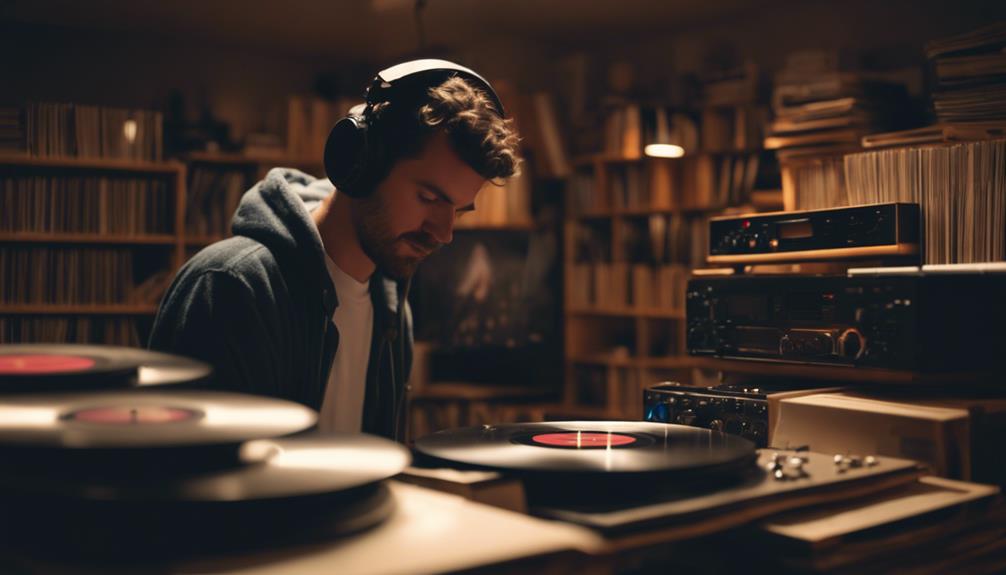
You’ve got plenty of options when it comes to finding samples for your music production. Online sample libraries and producer kits offer a wide array of royalty-free sounds.
While digging through vinyl can give you that warm, analog feel.
Don’t forget about field recording techniques to capture unique sounds from your environment.
Online Sample Libraries
Online sample libraries offer an extensive array of high-quality sounds, making it easier for producers to find the perfect sample for their music. These platforms provide access to a diverse range of samples, including drums, instruments, vocals, and FX. With the convenience of online sample libraries, you can quickly explore curated collections sorted by genre, instrument type, and mood, saving you precious time during your music production process.
One of the greatest advantages of using online sample libraries is the availability of royalty-free samples. This means you can legally use these sounds in your projects without worrying about copyright issues.
Here are some benefits of using online sample libraries:
- Wide Variety: Access thousands of samples from different genres and instruments.
- Curated Collections: Easily find samples organized by mood, genre, or instrument type.
- Royalty-Free: Use samples legally in your music without extra costs.
- Time-Saving: Quickly find and download the perfect sample without endless searching.
- Inspiration: Discover new sounds that spark creativity and elevate your music.
Digging Through Vinyl
Crate digging through vinyl records is a treasure hunt where you can unearth unique samples that add warmth and character to your music. This process, known as crate digging, involves sifting through vinyl records at record stores or online platforms like Discogs to find those hidden gems.
Sampling from vinyl offers a rich source of analog sounds, providing textures and imperfections that can enhance the authenticity of your tracks. Vinyl records capture an era’s essence, and sampling them allows you to bring a piece of music history into your modern compositions.
The tactile experience of handling vinyl connects you directly to the music, making the sampling process more immersive and personal. As you dig through crates, you’ll encounter a diverse range of music styles and genres, broadening your palette and creative possibilities.
Moreover, vinyl sampling isn’t just about taking snippets of music; it’s about reinterpreting classic tracks and giving them a fresh perspective. You’ll find that the unique character of vinyl samples can bring a new dimension to your productions, setting them apart from the digital sounds common in today’s music.
Field Recording Techniques
Field recording opens up a world of creative possibilities by capturing sounds from real-world environments like bustling streets, serene parks, and untamed nature. These unique audio snippets can be manipulated, processed, and integrated into your music compositions, adding unique textures and atmospheres that studio recordings just can’t replicate.
To get started with field recording, you’ll need a few essential tools and techniques. A portable recorder is your primary device, but pairing it with high-quality microphones can greatly enhance your audio capture. Don’t forget wind protection; even a slight breeze can ruin an otherwise perfect sample.
Here are some tips to help you find and capture the best sounds:
- Scout Locations: Identify places with interesting sounds, whether it’s a busy market or a tranquil forest.
- Time of Day: Different times offer different ambient noises. Early mornings and late evenings often provide unique sonic opportunities.
- Get Close: To capture clear sounds, bring your microphone as close to the source as possible.
- Record in Binaural: Use binaural microphones for a 3D audio effect that immerses listeners.
- Be Patient: Sometimes, the best sounds come when you least expect them, so keep recording.
Sampling from field recordings gives you endless creative avenues to explore, making your tracks truly one-of-a-kind.
Using Samples in Your DAW
When you’re prepared to start using samples in your DAW, simply drag and drop audio files directly into the workspace. This straightforward action lets you instantly integrate new audio into your project.
Once you’ve got your samples in place, you can utilize slicing and chopping tools to carve out specific segments of the sample for further manipulation.
To make your workflow smoother, assign different sample slices to MIDI notes. This approach allows you to trigger and arrange these segments effortlessly within your composition.
Try experimenting with the time-stretching and pitch-shifting tools in your DAW to adjust the tempo and pitch of your samples. These features give you the flexibility to fit samples seamlessly into your track, regardless of their original tempo or key.
Don’t forget to apply effects like reverb, delay, and EQ to shape and enhance your sampled sounds. Adding these effects can bring depth and dimension to your production, helping you achieve a polished, professional sound.
Sampling Techniques

How can you creatively manipulate audio samples to elevate your music production?
Using various sampling techniques, you can transform ordinary sounds into extraordinary elements in your tracks. Techniques like looping, chopping, layering, and reversing provide a wealth of creative possibilities.
Looping allows you to repeat a specific section of a sample seamlessly, creating a rhythmic foundation or a melodic motif.
Chopping involves slicing a sample into smaller segments, giving you the flexibility to rearrange and play them in new sequences.
Layering multiple samples can add depth and complexity, blending different textures and tones to enrich your sound.
Here are some key techniques to explore:
- Looping: Repeat sections of a sample to create consistent rhythms or motifs.
- Chopping: Cut the sample into smaller pieces for more creative control.
- Layering: Combine multiple samples for a richer, more textured sound.
- Pitch Shifting: Alter the pitch of a sample to fit your track’s key.
- Time Stretching: Change the tempo of a sample without affecting its pitch.
Software like Ableton Live and hardware samplers such as the Akai MPC offer powerful tools to implement these techniques.
Enhancing Your Tracks With Samples
Leveraging samples in your music production can elevate your tracks by adding unique depth and texture. Start by layering samples with your original compositions. This creates dynamic and engaging music that stands out.
Sampling allows you to incorporate unique sounds and elements into your tracks, making them more compelling and rich. Experiment with tempo changes, pitch shifting, and time stretching to transform samples into new, exciting sounds. These techniques can breathe fresh life into your tracks, making them distinct and innovative.
For example, slowing down a sample can reveal hidden details, while pitch shifting can add unexpected harmonics. Effective sample processing is vital for blending samples seamlessly into your mix. Use EQ to carve out space for samples, ensuring they complement rather than clash with your other elements.
Compression can control the dynamics, making the sample fit better within the overall mix. Adding reverb can give your samples a sense of space and cohesion.
Sampling in music production isn’t just about reusing existing sounds; it’s about creative recontextualization. By enhancing tracks with thoughtful sample processing and innovative techniques, you can offer fresh perspectives that keep listeners engaged and intrigued.
Next up, learn all about sound selection in this guide.
